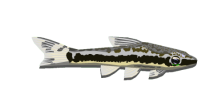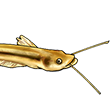Hey Jools,
I´ll try a translation. Though I only translate what Seidel/Evers call "Specialties", since we´re not concerned about Location and Keeping advices, I believe..
Bes.: Während Jungfische sehr stark an L. Pardalis erinnern, ist zumindest bei semiadulten Exemplaren eine sichere Bestimmung einfach. Keine andere Liposarcus-Art besitzt nämlich auf der Bauchseite ein Muster aus gewundenen schwarzen Linien. Und auch die Oberkörperzeichnung ist ziemlich eindeutig. Auf dem Kopf zeigen die Tiere wie L. Pardalis ein feines Wurmlinienmuster. Dahinter folgt dann allerdings ein Muster aus dunklen vertikalen Linien, die entlang der Ränder der Knochenplatten angeordnet sind. Auf der Brust- und Bauchflossenverlaufen schwarze Linien entlang der Strahlen. Der oberste Schwanzflossenstrahl ist verlängert und schwarz und wei� geringelt.
from: I. Seidel, H.-G. Evers, Mergus WelsAtlas 2, 1. Auflage, 2005, Mergus Verlag GmbH, Melle.
Now for the (free) translation (by myself

):
Specialties: While young fish resemble L. Pardalis very much, at least with semiadult fishes a fairly certain Identification is rather easy. No other Liposarcus-species has an underside marked with wound, black lines. Also, the body coloration is fairly typical. The head is, like L. Pardalis, marked with fine, wormlike lines. But in L. Disjunctivus, this is then followed by dark, vertical lines along the margins of the bone plates. The paired fins show black lines following the fin rays. The first ray of the caudal fin is lengthened and carries black/white rings.
Hope, that helps,
Greetings, Sandor
"What gets us into trouble is not what we don´t know.
It´s what we know for sure that just ain´t so."
--Mark Twain











